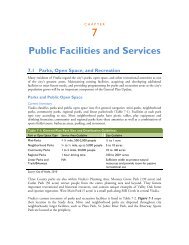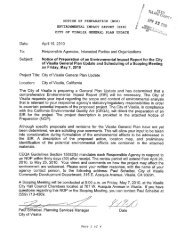General Plan Update Review Committee Draft Elements Part 2 For ...
General Plan Update Review Committee Draft Elements Part 2 For ...
General Plan Update Review Committee Draft Elements Part 2 For ...
You also want an ePaper? Increase the reach of your titles
YUMPU automatically turns print PDFs into web optimized ePapers that Google loves.
8-2<br />
VISALIA GENERAL PLAN UPDATE<br />
Expansive Soils<br />
Expansive soils have the potential to shrink or swell<br />
significantly with changes in moisture content, which<br />
can limit the development capacity of an area. The<br />
type and amount of the silt and clay content in the<br />
soil will determine the amount of shrink or swell<br />
associated with the various levels of water content.<br />
Soils comprised of sand and gravel are not expansive<br />
soils.<br />
Expansive soils are most likely to be found in basins<br />
and basin rims. Any structure located on expansive<br />
soils can be significantly damaged should the soil suddenly<br />
shrink or swell. Structural damage may result<br />
over a long period of time, usually from inadequate<br />
soils and foundation engineering or the placement of<br />
structures directly on expansive soils. Construction<br />
in areas of expansive soils may require major subexcavation<br />
and replacement of existing materials with<br />
more stable soils.<br />
Soil types considered to have a moderate “shrinkswell”<br />
potential underlie about 2,480 acres in the<br />
<strong>Plan</strong>ning Area, and are located near the Highway<br />
99/198 interchange, north of the St. Johns River, and<br />
in the northwest near the intersection of Road 80 and<br />
Avenue 328. See Figure 6-3: Erosion Susceptibility<br />
and Shrink-Swell Potential, in Chapter 6.<br />
Subsidence<br />
Subsidence occurs when a large portion of land is<br />
displaced vertically, usually due to the withdrawal of<br />
groundwater, oil, or natural gas. Soils that are partic-<br />
ularly subject to subsidence include those with high<br />
silt or clay content. Some areas in the Central Valley<br />
have subsided more than 20 feet during the past 50<br />
years. 1 Subsidence may occur in the <strong>Plan</strong>ning Area,<br />
particularly in areas with high clay content soils or<br />
due to groundwater withdrawal.<br />
Seismic Hazards<br />
There are no known active earthquake faults in the<br />
<strong>Plan</strong>ning Area. The closest active faults are Owens<br />
Valley fault group and Sierra Nevada Fault Zone,<br />
75 miles to the east of the <strong>Plan</strong>ning Area, the San<br />
Andreas Fault Zone (60 miles to the west), and an<br />
unnamed fault group north of Bakersfield (60 miles<br />
to the south). 2 Major earthquakes such as the 1906<br />
San Francisco, 1952 Kern County, and 1983 Coalinga<br />
quakes were felt and caused some minor to<br />
moderate property damage in Visalia. It is possible,<br />
but unlikely, that previously unknown faults could<br />
become active in the area. The State Geologist has<br />
not delineated any Alquist-Priolo Earthquake Fault<br />
Zones within or near the <strong>Plan</strong>ning Area.<br />
Groundshaking<br />
The most significant hazard associated with earthquakes<br />
for the Visalia area is ground shaking caused<br />
by earthquakes along the San Andreas fault to the<br />
west or Owens Valley fault to the east. However, the<br />
hazards due to groundshaking are considered to be<br />
low, according to the California Geological Survey<br />
and US Geological Survey’s Probabalistic Seismic<br />
Hazard Analysis. The analysis is based on historic<br />
1 Tulare County, <strong>General</strong> <strong>Plan</strong> Background Report, October 2004.<br />
pg. 8-11.<br />
2 USGS Fault Maps, http://quake.wr.usgs.gov/info/faultmaps




